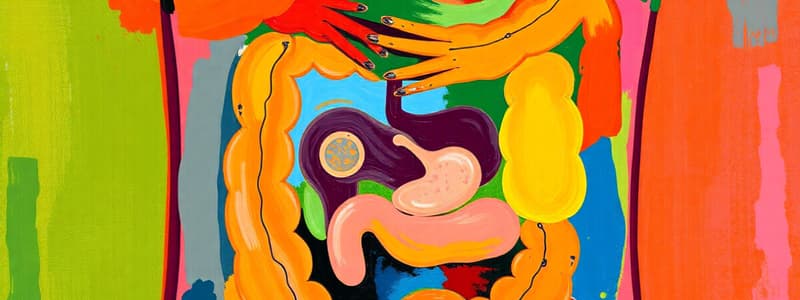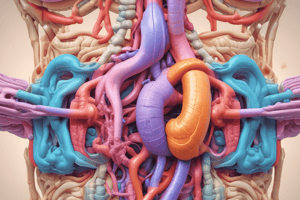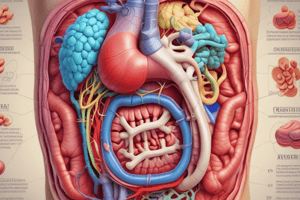Podcast
Questions and Answers
What is one consequence of decreased gastric motility and delayed gastric emptying?
What is one consequence of decreased gastric motility and delayed gastric emptying?
- Reduced appetite
- Increased risk for ulcer formation (correct)
- Enhanced absorption of nutrients
- Improved mucosal barrier function
Which change occurs in the liver with aging?
Which change occurs in the liver with aging?
- Improved detoxification abilities
- Increased liver weight
- Decreased blood flow (correct)
- Enhanced hepatic regeneration
What aspect of intestinal health is commonly affected with age?
What aspect of intestinal health is commonly affected with age?
- Stable intestinal microbiota composition
- Increased villi height
- Shorter and more convoluted villi (correct)
- Improved mucosal immunity
What is a common condition related to the decline of rectal muscle mass?
What is a common condition related to the decline of rectal muscle mass?
What happens to the secretion of digestive enzymes in the pancreas with aging?
What happens to the secretion of digestive enzymes in the pancreas with aging?
What is the primary role of the villi and microvilli in the small intestine?
What is the primary role of the villi and microvilli in the small intestine?
Which of the following is NOT a function of the gastrointestinal (GI) tract?
Which of the following is NOT a function of the gastrointestinal (GI) tract?
How does peristalsis contribute to the digestive process?
How does peristalsis contribute to the digestive process?
What initiates the process of intestinal digestion?
What initiates the process of intestinal digestion?
What is the primary component of saliva that aids in digestion?
What is the primary component of saliva that aids in digestion?
Where in the gastrointestinal tract does absorption primarily occur?
Where in the gastrointestinal tract does absorption primarily occur?
Which of the following is NOT a function of bile?
Which of the following is NOT a function of bile?
What role does the intestinal microbiome play in digestive health?
What role does the intestinal microbiome play in digestive health?
Which organ produces bile?
Which organ produces bile?
Which section of the large intestine receives chyme from the ileum?
Which section of the large intestine receives chyme from the ileum?
What triggers the gallbladder to begin contracting and releasing bile?
What triggers the gallbladder to begin contracting and releasing bile?
What characteristic of the stomach helps to kill ingested pathogens?
What characteristic of the stomach helps to kill ingested pathogens?
What is the primary composition of bile?
What is the primary composition of bile?
Which statement about aging and the GI system is correct?
Which statement about aging and the GI system is correct?
Which cells in the pancreas are responsible for secreting digestive enzymes?
Which cells in the pancreas are responsible for secreting digestive enzymes?
What role does the liver play in hemostatic functions?
What role does the liver play in hemostatic functions?
Flashcards
Intestinal Digestion
Intestinal Digestion
The breakdown of food in the small intestine, involving pancreatic, intestinal enzymes, and bile.
Bile Function
Bile Function
Aids in the digestion and absorption of fats and is made in the liver and stored in the gallbladder.
Gallbladder Function
Gallbladder Function
Stores and concentrates bile between meals, releasing it when needed. Stimulated by hormones.
Liver Function
Liver Function
Signup and view all the flashcards
Pancreas (Exocrine)
Pancreas (Exocrine)
Signup and view all the flashcards
Digestion Stages
Digestion Stages
Signup and view all the flashcards
Aging Impacts Oral Cavity
Aging Impacts Oral Cavity
Signup and view all the flashcards
Nutrient Absorption
Nutrient Absorption
Signup and view all the flashcards
GI Tract Function
GI Tract Function
Signup and view all the flashcards
Ingestion (GI)
Ingestion (GI)
Signup and view all the flashcards
Small Intestine Parts
Small Intestine Parts
Signup and view all the flashcards
Large Intestine Movement
Large Intestine Movement
Signup and view all the flashcards
Peritoneum Function
Peritoneum Function
Signup and view all the flashcards
Intestinal Microbiome Composition
Intestinal Microbiome Composition
Signup and view all the flashcards
Saliva Composition
Saliva Composition
Signup and view all the flashcards
Stomach role
Stomach role
Signup and view all the flashcards
Aging Liver Changes
Aging Liver Changes
Signup and view all the flashcards
Intestinal Microbiota Shifts
Intestinal Microbiota Shifts
Signup and view all the flashcards
Digestive Enzyme Decline
Digestive Enzyme Decline
Signup and view all the flashcards
Impaired Nutrient Absorption
Impaired Nutrient Absorption
Signup and view all the flashcards
Brain-Gut Axis Disruption
Brain-Gut Axis Disruption
Signup and view all the flashcards
Study Notes
Digestive System Structure and Function
- The digestive system is a series of organs that process food, extract nutrients, and eliminate waste.
- The GI tract is responsible for ingestion, propulsion, secretions, mechanical digestion, chemical digestion, absorption, and elimination.
Functions of the GI Tract
- Ingestion: taking food into the mouth
- Propulsion: moving food through the GI tract
- Secretion: release of fluids, mucus, and enzymes
- Mechanical digestion: breaking food into smaller pieces
- Chemical digestion: breaking down food molecules with enzymes
- Absorption: moving nutrients into the bloodstream
- Elimination: removing waste products from the body
Organs of the GI Tract
- Oral cavity: chewing, mixing with saliva
- Teeth: mechanical digestion
- Tongue: taste buds, moving food
- Salivary glands: saliva production
- Pharynx: swallowing
- Esophagus: transportation to the stomach
- Stomach: storage, mixing, breakdown of food
- Liver: bile production, nutrient storage, detoxification
- Gallbladder: bile storage and concentration
- Pancreas: digestive enzymes, bicarbonate production
- Small intestine: enzymatic digestion and absorption
- Large intestine: water absorption, waste compaction and elimination
- Rectum: storage of waste
- Anus: elimination of waste
The Gastrointestinal Tract
- Mouth: reservoir for chewing and mixing food with saliva; contains water, mucus, sodium, bicarbonate, chloride, potassium and salivary amylase.
- Tongue: covered in taste buds; involved in food manipulation and swallowing
- Esophagus: peristalsis transports food bolus to stomach
- Stomach: involved in mechanical and chemical breakdown of food; produces chyme;
- Small intestine: absorption of digested food through villi and microvilli
- Large intestine: absorption of water and compaction of waste; segments include cecum, ascending, transverse, descending and sigmoid colon
- Peritoneum: membrane surrounding organs of abdomen and pelvic cavity; visceral peritoneum covers organs and parietal peritoneum lines body walls.
Intestinal Microbiome
- Bacteria increase along the length of the GI tract, highest in the colon
- Multiple factors affect bacterial flora composition including - genetics, diet, environment and medications.
- The immune system is alerted to infection in the gut
- Intestines are initially sterile but are colonized after birth.
- Bacteria number and diversity decreases with age.
- Stomach acid inhibits bacterial growth.
Intestinal Digestion & Absorption
- Digestion begins in the stomach with hydrochloric acid and pepsin.
- In the small intestine, pancreatic enzymes, intestinal enzymes and bile salts further break down food.
- Nutrients are absorbed via active transport, diffusion, or facilitated diffusion.
- Carbohydrates, proteins, and fats are important nutrient groups.
Accessory Organs of Digestion
- Liver (hepatocytes): produces bile; involved in nutrient processing.
- Gallbladder: stores bile
- Pancreas: exocrine and endocrine - producing enzymes and hormones.
Bile
- Bile is an alkaline, bitter-tasting liquid, made in the liver to assist in fat digestion and absorption and is stored in the gallbladder.
- Bile contains bile salts, cholesterol, and bilirubin.
Liver Functions
- Stores blood, and aids in clotting factor synthesis (vitamin K)
- Processes nutrients (carbohydrates, fats, and proteins).
- Detoxifies metabolic wastes
- Stores minerals and vitamins.
Aging and the GI System
- Oral Cavity & Esophagus: Enamel deterioration, reduced taste buds, and salivary secretion decrease which can affect chewing and swallowing in older age.
- Stomach: Changes in gastric motility, hydrochloric acid production and protective mucosal barrier, which increase the risk of ulcers.
- Liver: Reduced ability to detoxify medications, and decreased blood flow affecting medication metabolism.
- Intestines: Change in microbiota, weakened mucosal immunity, shorter and less effective villi, reduced motility and weakened anal sphincter can cause constipation, fecal impaction and incontinence
- Pancreas & Gallbladder: Fibrosis, fatty deposits and pancreatic atrophy can reduce enzyme production - causing decreased digestive enzyme production and increased gallstones.
Studying That Suits You
Use AI to generate personalized quizzes and flashcards to suit your learning preferences.




